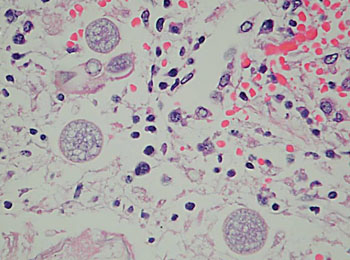Microarray Diagnostic Tool Helps Diagnose Valley Fever
By LabMedica International staff writers
Posted on 06 Aug 2014
Valley fever (VF) is a fungal respiratory infection and can be acquired when microscopic spores of the soil-dwelling fungus are inhaled and VF is difficult to diagnose partly because symptoms are confounded with other community-acquired pneumonias.Posted on 06 Aug 2014
Two forms of the fungus exist, Coccidioides immitis and C. posadasii and confirmatory diagnostics detect immunoglobulin M (IgM) and IgG antibodies against Coccidioidal antigens via immunodiffusion (ID). However the false negative rate can be as high as 50% to 70% with 5% of symptomatic patients never showing detectable antibody levels.

Image: Photomicrograph of Coccidioides immitis in lung tissue showing as large, irregularly sized thick walled spherules (Photo courtesy of Dr. William McDonald, MD).
Scientists at Arizona State University (Temple, AZ, USA) obtained a cohort of 55 VF samples and a blinded test set of 67 samples as de-identified human patient sera. In order to test whether different infections are discernable, patient sera representing 19 Aspergillus fumigatus, 19 Mycoplasma pneumoniae, and 19 Chlamydia pneumoniae samples were processed alongside 18 VF and 31 healthy sera.
The microarray platform consists of a glass slide imprinted with 10,000 (10K) peptides. Each peptide consists of a string of 20 amino acids, randomly arranged. The power of the technology resides in the fact that the randomly generated peptides are not based on natural antigens to Coccidioides or indeed, any disease. They are "unbiased" to the nature of particular disease antibodies and can therefore act as a sort of universal diagnostic. The peptides are spotted onto standard slides using noncontact piezo printer. The slides were scanned on the SureScan Microarray C Scanner (Agilent Technologies; Santa Clara, CA, USA). Once an immunosignature for VF was established using the 10K peptide microarray, a smaller diagnostic array was composed from relevant diagnostic peptides. This smaller 96-peptide array was then tested for accuracy against the current immunodiffusion diagnostic standard.
The 10K peptide array successfully distinguished Valley fever from three other infections, with 98% accuracy. Impressively, the method also was able to classify false negative VF patients in a blinded test, with 100% accuracy, easily outpacing existing immunodiffusion methods, which could only identify 28% of false negatives. The smaller, 96 peptide diagnostic array showed less specificity than the 10K peptide array in terms of identifying false negatives. The authors propose that the larger 10K peptide array be used in initial screenings, followed by subarrays with reduced complements of carefully selected peptides, used for clinical diagnosis. The study was published ahead of print on June 25, 2014, in the journal Clinical and Vaccine Immunology.
Related Links:
Arizona State University
Agilent Technologies




 assay.jpg)








